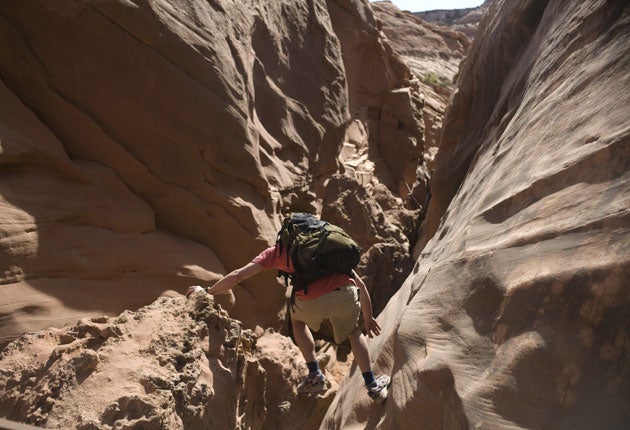127 Hours, Danny Boyle, 95 mins (15)
Danny Boyle's razzle-dazzle storytelling so dissipates the true drama of this story of a man who amputates his own limb, you wouldn't give your right arm to see it

One thing is beyond doubt: Danny Boyle's 127 Hours has a hell of a story to tell.
In 2003, Aron Ralston went for a weekend exploring the canyons of Utah and found himself trapped down a chasm, his arm jammed inextricably under a fallen boulder. After days alone, unable to summon help, Ralston freed himself by amputating his own limb with a penknife. You can have nothing but awe-struck admiration for Ralston, who lived to write an account of his ordeal – although I confess my regard is slightly diminished by his calling the book Between a Rock and a Hard Place. He might as well have gone for A Farewell to Arms.
This tale of solitary confinement followed by amputation could well have given us something like Samuel Beckett with a torture-porn climax. You certainly wouldn't have expected a film quite as exuberant as Danny Boyle has made here. 127 Hours comes on firing from the get-go, with split-screen imagery in vivid colours, showing multitudes at a football match, at Mecca, on the financial trading floors – then dropping in the solitary figure of Ralston, played by James Franco. To booming rock (the score is largely by star Bollywood composer A R Rahman), Ralston drives overnight, then in the morning – kaboom! – hurtles on his bike across the widescreen desert, filming himself on his camcorder as he goes. Striding into canyon country, he meets two young women and initiates them into the exhilarating art of plunging down rock chasms into blue underground pools – the camera plunging headily with them.
When the rock jams his arm, we get a brief, terrible moment of calm realisation as Ralston is, for the first time, stopped in his tracks. Things get serious – but Boyle isn't about to let them get solemn. When Ralston tries to whittle at the boulder, it's a desperately tense, dramatic moment – so why does Boyle need to telegraph the tension with chugging rock guitar?
Overall, the film dissipates suspense with bursts of furious energy, turning a story of solitary entrapment into a three-ring circus of the senses. There's barely a moment that doesn't feature some giddy effect, and many are certainly striking: the camera rockets away from Ralston wedged deep in his gulley, then vaults into the skies to reveal his prison as a tiny fissure in a vast ochre desolation. Playing throughout with extremes of scale, the photography – by Anthony Dod Mantle and Enrique Chediak – offers impossible, dimension-defying close-ups. The camera takes us into the tube of Ralston's drinking bottle as water rushes to his mouth, and later, superfluously, right inside the workings of his camcorder.
There's also a moment of grotesque comedy as Ralston, staring his predicament in the face, stages his own chat show, playing sheepish guest and mocking, castigating host. What could have been an embarrassing routine is smartly written by Boyle and Simon Beaufoy, and carried off with aplomb by Franco, who captures Ralston's mix of uncrushable goofiness and self-lacerating anxiety. Throughout the film, Franco conveys a frazzled dignity and vulnerability, giving Ralston sufficient depth so that we're not merely rooting for him as an endurance champion.
But the film doesn't trust in the hard horrifying drama that is Ralston's lonely moment of truth. Boyle treats us to a constant spectacular, often of the thoughts in his hero's troubled head. There are wistful flashbacks to family moments, and an apocalyptic production number in which storm clouds open up over the canyon. There's also a misjudged fantasy in which the camera pelts across the desert and into the back of Ralston's van, coming to rest on a bottle of Gatorade – followed by a montage of soft drink ads because, as we might not have noticed, Ralston's getting a little thirsty. 127 Hours features some extremely striking, often beautiful images. But as a result of all the showmanship, there's barely a moment when we feel real tension – still less, feel as trapped or as panicked as Ralston.
The final horror of amputation is evoked with finesse: you may wince, but you're unlikely to faint (and if you did, it would be from Boyle's judicious use of a dentist's drill sound). Ralston's eventual liberation is utterly triumphant, as signalled by a martial swell of Sigur Ros music; but we never feel we earn the release by truly living through hell with our hero.
You wonder what the film might have been if Boyle had eschewed the dazzle and simply given us a man in a squeeze. Look what the mountaineering documentary Touching the Void did with a similarly extreme situation, and consider last year's compelling minimalist thriller Buried – simply one actor stuck in a coffin.
Instead of an existential drama of anguished endurance, Boyle has made an all-out entertainment: an extreme sports movie about an extreme dude. 127 Hours is so jam-packed with cinema that there's not much room for a film – at least, not the subtler, more psychologically challenging one that Ralston's unimaginably troubling, improbably positive story deserves.
Next Week:
Jonathan Romney watches troubled romance, US indie style, in Blue Valentine
Join our commenting forum
Join thought-provoking conversations, follow other Independent readers and see their replies
Comments
Bookmark popover
Removed from bookmarks